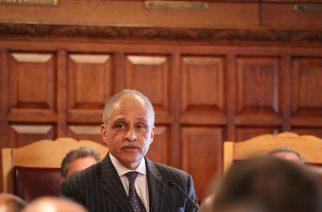
Governor Andrew Cuomo tours construction of temporary FEMA hospital at Jacob K. Javits Convention Center.
Construction on temporary hospital sites in Westchester, Manhattan and Long Island could begin as early as this week to address imminent capacity issues in the area. As of Monday, New York has seen over 20,000 confirmed cases of COVID-19, with over 2,000 hospitalizations and 157 deaths.
Gov. Andrew Cuomo accepted the Army Corps of Engineers’ recommendation to build four temporary hospital sites at the Westchester County Center in White Plains, the Jacob K. Javits Center in Manhattan, and locations at SUNY Stony Brook and SUNY Westbury in Long Island. The Javits Center will also be the site of four additional federal hospital facilities constructed by FEMA, with 250 beds each, and is expected to be completed within a week to ten days, according to Cuomo.
The governor also announced that the state is looking for existing health care facilities that can be repurposed as temporary hospitals; so far, a Brooklyn nursing home has been selected with a capacity of 600 beds.
“To get through this crisis we need to be sure our hospitals and health care system have the equipment, facilities and staff they need to treat patients and save lives,” Cuomo said Sunday.
New York state is also attempting to increase the capacity of their existing hospitals. Currently, there are 53,000 hospital beds in the state, and it is projected that 110,000 will be needed. Cuomo issued an emergency order to hospitals to increase their capacity by at least 50 percent, with a goal of getting to 100 percent if possible.
To deal with the increased capacity, the state has also reached out to all retired medical professionals and nursing and medical schools to ask them to enlist to help with 30,000 responses so far, and an executive order has been signed to order all registered nurses in the state to enlist.
New York state health care workers are also seeking more medical supplies, such as face masks, other personal protective equipment and ventilators. The state has had some success obtaining supplies, and is distributing them to healthcare facilities around the state, but Cuomo once again urged the federal government to implement the Federal Defense Production Act. This would direct companies to produce enough of these resources to meet the national need, so that states do not have to compete and bid for them.
“Yes, it is an assertion of government power on private sector companies, but so what?” Cuomo said Monday. “This is a national emergency. You cannot continue to do these supplies on an ad hoc basis.”
While it is likely that many more thousands of infections will happen—as Cuomo estimated Sunday, 40 to 80 percent of New York’s population may contract the virus— “social distancing” and quarantine measures have been introduced in order to stagger the spread of the illness over a longer period of time so that healthcare facilities’ capacities are not overwhelmed at once, a concept known as “flattening the curve.”
New York’s number of cases is growing exponentially, which is expected as testing capacity increases, but its death toll is rising rapidly as well. As The New York Times updated this weekend, deaths from COVID-19 in New York state are doubling every two days. The temporary hospital sites and increased hospital capacity are preparations for this increasing number of serious cases, so that healthcare facilities will not be forced to make decisions about turning critical patients away, as they have had to do in Italy.










